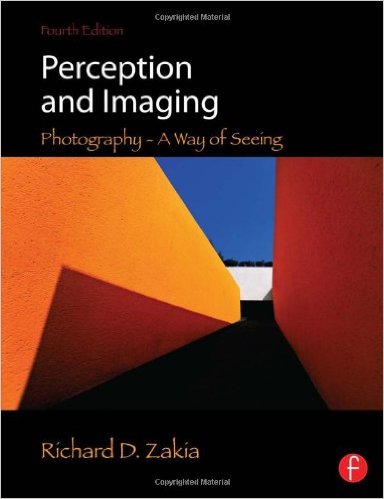 Perception and Imaging: Photography–A Way of Seeing is a book of the sort that all photographers should read. Especially aspiring photographers. Perception and Imaging is basically an academic text book, but I’m not being smug when I say that aspiring photographers should read it. Rich Zakia, the book’s author, writes:
Perception and Imaging: Photography–A Way of Seeing is a book of the sort that all photographers should read. Especially aspiring photographers. Perception and Imaging is basically an academic text book, but I’m not being smug when I say that aspiring photographers should read it. Rich Zakia, the book’s author, writes:
“The technology will continue to change, but the process of visual perception will remain essentially the same.”
Photographers just starting out today are mainly learning techniques or methods. Asking, “How do I get this look?”… “How do I capture this thing”… “How do I shoot in this place?”… Instead of the more mindful questions like “what is this look?”, “why do I want to capture this thing?”, and “when do I shoot in this place?”. Those “how” questions are important too, but navigating from them to another branch on the creative tree is hard to do. It’s like learning to sing a song in a language you don’t know. You can sing that song perfectly, but learning it doesn’t help you sing other songs in that language very much.
Art is like a language. An amorphous one, with much room for interpretation, sure. But the comparison fits.
Art, in the visual medium, is more than just knowing that people like symmetry and repeating lines. It’s the entwinement of intention and execution. If you were to fake the Chinese language with a bunch of short sounds ending in “ng”, you might once in a while stumble upon a real phrase with meaning, and you’d probably be pretty good at stumbling on those phrases if you overheard people speaking Chinese on a regular basis. Take this video from Adriano Celentano:
Or this dramatic one, from Youtubers, Brian & Karl.
The creators of these videos are attempting to sound like they are speaking english, but they’re not. They’re doing a caricature of it, the way an english speaker might do a caricature of Chinese. Though notably less offensive.
How long could you watch a move made in the way Brian & Karl made that video? How many songs could you listen to that were just gibberish before you started wishing the words meant something? Once the novelty wore off, probably not very long. By and large, we like those videos up there because the creators had the original idea, and the execution was excellent, not just because the finished product itself is actively enjoyable. We’d start to feel differently after a few other people used the method. But this is, in effect, what a lot of photographers are doing. Many are just learning how to make some specific sounds people seem to like, without understanding how they string together, and without recognizing the meaning in the sounds they hear.
Also coming to mind is this subversive artist, and possible creeper (it’s still too soon to tell). They have invested huge sums of money and time into recreating, with near perfection, a popular Instagrammer’s feed. It’s not clear if they are making a statement, but to me, it reads like they are pointing a judgmental finger and saying they don’t need any connection to the creative process, they only have to know which steps to take. How different is the work from the finished work? This artist seems to be saying, perhaps sarcastically, as long as you put in the work, it doesn’t matter if you create something identical to someone else. Are we artists for putting together are Ikea furniture?
This is what happens when you learn method and technique first and foremost. You get nearly identical images of the word “love” written on a long exposure with sparklers. You get a photo of your baby that looks virtually identical to your neighbor’s. You get the same top-down spread of flattened, vintage camera gear on bamboo countertop. We ask “what does this mean?” less, and start asking “does this look like the others?” more.
Perception and Imaging is not a book that will teach anyone to take a photo. Instead, it teaches you the language of visual art. When you learn to speak the language, you can say almost anything. Learning how the sounds of visual art are pronounced is still impassably important; you must know the answers to the “how” questions. But lets be real… those questions are not difficult to answer. About 90% of the technical stuff you really need to know to capture just about whatever you want, can be integrated into second-nature in about 40 hours. Less than a month if you found two hours of practice a day consistently.
As I said, this is almost a textbook, and it goes way down to the foundations of visual language. It doesn’t just impress that repeating lines and vanishing points are pleasing, it helps explain why, which in turn helps you predict what other groupings might be pleasing. It doesn’t just tell you to put your subject on the intersection, it covers the origins of the rule of thirds and explores alternatives. It tackles the ambiguous concepts of time and continuity in a still image. It gets into the nitty gritty of how and what naturally comes out of a photographer when the conditions are right. It also has plenty to say about the hidden technicalities of image creation, such as color calibrations and the biology of the human eye.
For now, creating eye catching images is much easier than it’s ever been. Just do what everyone else is doing, but join the trend early. Soon though, the bubble will burst, and the trend might become toxic. The photographers caught trend-hopping will start to sound like an intolerant person making fun of the Chinese language. The only hope is to try to generate original thoughts. Focusing on those “how” questions, after you’ve already grasped the technical basics, makes that supremely difficult. Perception and Imaging, and surely many other books like it, is helping teach what you’ll need to know to generate those original thoughts.

Recent Discussion